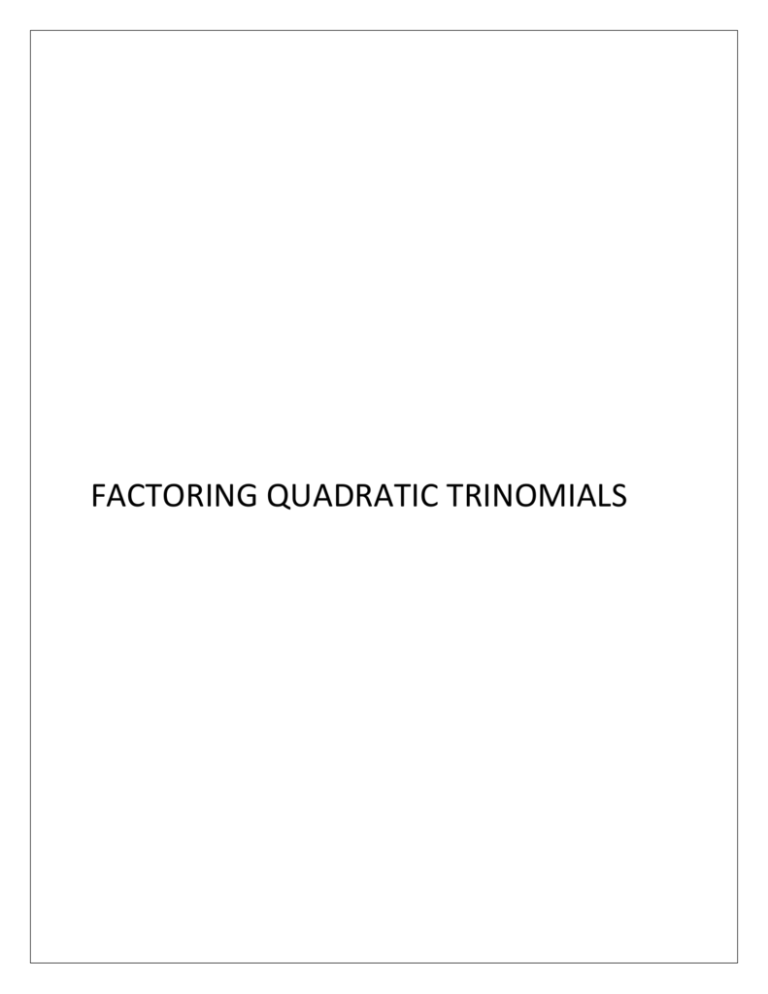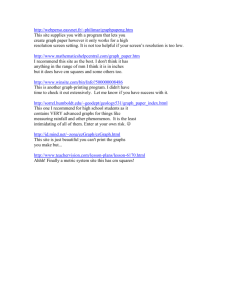
FACTORING QUADRATIC TRINOMIALS
PERFECT SQUARE & CUBE TRINOMIALS
There are other patterns that trinomials have which are not apparent. In order to understand those we
will look at a concept called perfect squares and perfect cubes.
The product of a term and itself is called a perfect square. The exponents on the variables of perfect
squares are always even.
Examples:
5
5*5
25
X
x*x
x2
3y
3y*3y
9 y2
The product of the same three factors is called a perfect cube. The exponents on variables of perfect
cubes can be divided by three.
Examples:
2
2*2*2
8
x2
x2* x2* x2
x6
3y
3y*3y*3y
27 y 3
So why is this important?
We can use this to help use factor terms which have these properties.
For example what if I told you to give me the perfect square factors of 81? The answer would be 9 and 9.
What about the perfect square factors of -81? The answer would be 9 and -9. What about the perfect
square factors of 49? The answer would be 7 and 7.
How about the perfect cube factors of 343? That would be 7, 7 and 7. That would be difficult to find, but
the only hint can be that you know it cannot be a perfect square.
We can represent these answers with exponential representation:
81 = 9*9 = 9 2
16 = 4*4 = 4 2
343 = 7*7*7 = 7 3
The numbers are okay to find out, what about the variables. What if I asked you to find the perfect
factors of variables? That actually turns out to much easier. If asked about perfect square factors then
just divide by two, if asked about perfect cube factors just divide by three
What are the perfect square factors of the following?
x8 = x 4 * x 4
x 10 = x 5 * x 5
What are the perfect cube factors of the following?
x6 = x2 * x2 * x2
x 12 = x 4 * x 4 * x 4
So if we were to put this together, what are the perfect square factors of the following?
81 x 8 = 9 x 4 * 9 x 4
-49 x 10 = 7 x 5 * -7 x 5
What are the perfect cube factors of the following?
343 x 6 = 7 x 2 *7 x 2 *7 x 2
We took a bunch of perfect square terms and factored them. We can actually now take these terms and
try to add or subtract them. This is how they would look.
25 + 9 y 2
343 x 6 - 8
The question is how do we factor them? Since we have perfect squares and perfect cubes there must be
a technique. We have the following formula which can help us.
FACTORING THE DIFFERENCE OF TWO PERFECT SQUARES
This expression is called a difference of two squares.
You may remember seeing expressions like this one when you worked with multiplying algebraic
expressions. Do you remember...?
If you remember this fact, then you already know that the factors of
Are
and
Example 1:
Factor x2 - 9
Both x2 and 9 are perfect squares. Since subtraction is occurring between these squares,
this expression is the difference of two squares.
2
What times itself will give x ? The answer is x.
What times itself will give 9 ? The answer is 3.
These answers could also
be negative values, but
positive values will make
our work easier.
The factors are (x + 3) and (x - 3).
Answer: (x + 3) (x - 3) or (x - 3) (x + 3) (order is not important)
Example 2:
Factor 4y2 - 36y6
There is a common factor of 4y2 that can be factored first in this problem.
4y2 (1 - 9y4)
4
In the factor (1 - 9y ), 1 and 9y4 are perfect squares (their coefficients are perfect squares and
their exponents are even numbers). Since subtraction is occurring between these squares, this
expression is the difference of two squares.
What times itself will give 1? The answer is 1.
What times itself will give 9y4 ? The answer is 3y2 .
The factors are (1 + 3y2) and (1 - 3y2).
Answer: 4y2 (1 + 3y2) (1 - 3y2) or 4y2 (1 - 3y2) (1 + 3y2)
__________________________________________________________
If you do not see the common factor, you can begin with observing the perfect squares. Both
4y2 and 36y6 are perfect squares (their coefficients are perfect squares and their exponents are
even numbers). Since subtraction is occurring between these squares, this expression is the
difference of two squares.
What times itself will give 4y2 ? The answer is 2y.
What times itself will give 36y6 ? The answer is 6y3 .
The factors are (2y + 6y3) and (2y - 6y3).
Answer: (2y + 6y3) (2y - 6y3) or (2y - 6y3) (2y + 6y3)
These answers can be further factored as each contains a common factor of 2y:
2y (1 + 3y2) • 2y (1 - 3y2) = 4y2 (1 + 3y2) (1 - 3y2)
Try the following (With solutions worked out):
Factor x2 – 16
This is x2 – 42, so I get:
x2 – 16 = x2 – 42 = (x – 4)(x + 4)
Factor 4x2 – 25
This is (2x)2 – 52, so I get:
4x2 – 25 = (2x)2 – 52 = (2x – 5)(2x + 5)
Factor 9x6 – y8
This is (3x3)2 – (y4)2, so I get:
9x6 – y8 = (3x3)2 – (y4)2 = (3x3 – y4)(3x3 + y4)
Factor x4 – 1 Copyright © Elizabeth Stapel 1999-2009 All Rights Reserved
This is (x2)2 – 12, so I get:
x4 – 1 = (x2)2 – 12 = (x2 – 1)(x2 + 1)
Note that I'm not done yet, because x2 – 1 is itself a difference of squares, so I need to apply the formula
again to get the fully-factored form. Since x2 – 1 = (x – 1)(x + 1), then:
x4 – 1 = (x2)2 – 12 = (x2 – 1)(x2 + 1)
= ((x)2 – (1)2)(x2 + 1)
= (x – 1)(x + 1)(x2 + 1)
FACTORING THE SUM AND DIFFERENCE OF TWO PERFECT CUBES
a3 + b3 = (a + b)(a2 – ab + b2)
a3 – b3 = (a – b)(a2 + ab + b2)
Try the following (With solutions worked out):
Factor x3 – 8
This is x3 – 23, so I get:
x3 – 8 = x3 – 2 3
= (x – 2)(x2 + 2x + 22)
= (x – 2)(x2 + 2x + 4)
Factor 27x3 + 1
Remember that 1 can be regarded as having been raised to any power you like, so this is really
(3x)3 + 13. Then I get:
27x3 + 1 = (3x)3 + 13
= (3x + 1)((3x)2 – (3x)(1) + 12)
= (3x + 1)(9x2 – 3x + 1)
Factor x3y6 – 64
This is (xy2)3 – 43, so I get:
x3y6 – 64 = (xy2)3 – 43
= (xy2 – 4)((xy2)2 + (xy2)(4) + 42)
= (xy2 – 4)(x2y4 + 4xy2 + 16)
Here are some videos that you can use for reference:
http://www.youtube.com/watch?v=z8U7JgFR_hw
http://www.youtube.com/watch?v=9IGgKCPMaJI
http://www.youtube.com/watch?v=Wok67Y690Co
http://www.youtube.com/watch?v=GlSY4xzfjvE
http://www.youtube.com/watch?v=apWn9pMygCc







